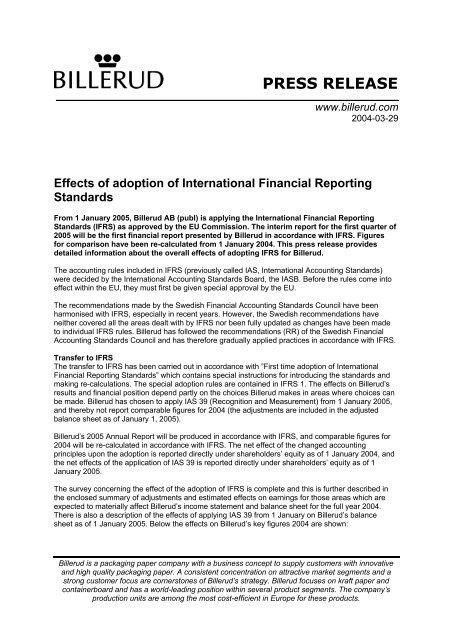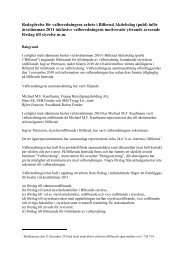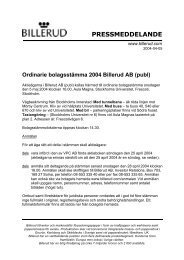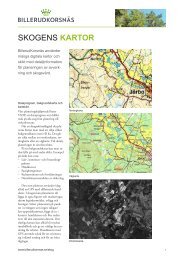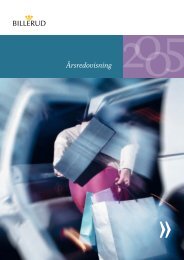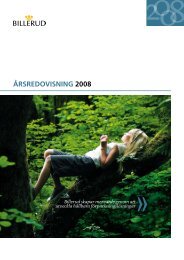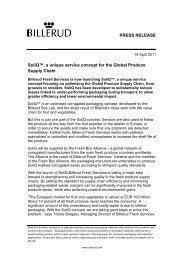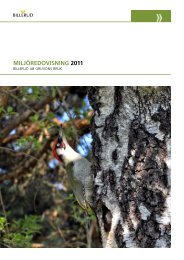PRESS RELEASE - Billerud AB
PRESS RELEASE - Billerud AB
PRESS RELEASE - Billerud AB
Create successful ePaper yourself
Turn your PDF publications into a flip-book with our unique Google optimized e-Paper software.
<strong>PRESS</strong> <strong>RELEASE</strong><br />
_________________________________________________________________________________<br />
www.billerud.com<br />
2004-03-29<br />
Effects of adoption of International Financial Reporting<br />
Standards<br />
From 1 January 2005, <strong>Billerud</strong> <strong>AB</strong> (publ) is applying the International Financial Reporting<br />
Standards (IFRS) as approved by the EU Commission. The interim report for the first quarter of<br />
2005 will be the first financial report presented by <strong>Billerud</strong> in accordance with IFRS. Figures<br />
for comparison have been re-calculated from 1 January 2004. This press release provides<br />
detailed information about the overall effects of adopting IFRS for <strong>Billerud</strong>.<br />
The accounting rules included in IFRS (previously called IAS, International Accounting Standards)<br />
were decided by the International Accounting Standards Board, the IASB. Before the rules come into<br />
effect within the EU, they must first be given special approval by the EU.<br />
The recommendations made by the Swedish Financial Accounting Standards Council have been<br />
harmonised with IFRS, especially in recent years. However, the Swedish recommendations have<br />
neither covered all the areas dealt with by IFRS nor been fully updated as changes have been made<br />
to individual IFRS rules. <strong>Billerud</strong> has followed the recommendations (RR) of the Swedish Financial<br />
Accounting Standards Council and has therefore gradually applied practices in accordance with IFRS.<br />
Transfer to IFRS<br />
The transfer to IFRS has been carried out in accordance with ”First time adoption of International<br />
Financial Reporting Standards” which contains special instructions for introducing the standards and<br />
making re-calculations. The special adoption rules are contained in IFRS 1. The effects on <strong>Billerud</strong>’s<br />
results and financial position depend partly on the choices <strong>Billerud</strong> makes in areas where choices can<br />
be made. <strong>Billerud</strong> has chosen to apply IAS 39 (Recognition and Measurement) from 1 January 2005,<br />
and thereby not report comparable figures for 2004 (the adjustments are included in the adjusted<br />
balance sheet as of January 1, 2005).<br />
<strong>Billerud</strong>’s 2005 Annual Report will be produced in accordance with IFRS, and comparable figures for<br />
2004 will be re-calculated in accordance with IFRS. The net effect of the changed accounting<br />
principles upon the adoption is reported directly under shareholders’ equity as of 1 January 2004, and<br />
the net effects of the application of IAS 39 is reported directly under shareholders’ equity as of 1<br />
January 2005.<br />
The survey concerning the effect of the adoption of IFRS is complete and this is further described in<br />
the enclosed summary of adjustments and estimated effects on earnings for those areas which are<br />
expected to materially affect <strong>Billerud</strong>’s income statement and balance sheet for the full year 2004.<br />
There is also a description of the effects of applying IAS 39 from 1 January on <strong>Billerud</strong>’s balance<br />
sheet as of 1 January 2005. Below the effects on <strong>Billerud</strong>’s key figures 2004 are shown:<br />
<strong>Billerud</strong> is a packaging paper company with a business concept to supply customers with innovative<br />
and high quality packaging paper. A consistent concentration on attractive market segments and a<br />
strong customer focus are cornerstones of <strong>Billerud</strong>’s strategy. <strong>Billerud</strong> focuses on kraft paper and<br />
containerboard and has a world-leading position within several product segments. The company’s<br />
production units are among the most cost-efficient in Europe for these products.
Key Figures 2004<br />
According to<br />
Swedish accounting rules According to IFRS<br />
Return on capital employed, % 17 17<br />
Return on shareholders’ equity, % 17 16<br />
Debt/equity ratio 0.48 0.48<br />
Earnings per share, SEK 9.75 9.66<br />
The following IAS/IFRS standards are considered to have the largest impact on <strong>Billerud</strong>’s<br />
comparable figures for 2004:<br />
• Reporting of pension liabilities in accordance with IAS 19( Employee Benefits). From 1 January<br />
2004, <strong>Billerud</strong> has applied RR29, which is in agreement with IAS 19 (Employee Benefits).<br />
• Reporting of restructuring reserves in connection with acquisitions, in accordance with IFRS 3<br />
(Business Combinations). According to IFRS 3, restructuring reserves may be included in the<br />
acquisition balance only if they have already been reported in the acquired company. <strong>Billerud</strong><br />
applies IFRS 3 as from 1 January 2004. <strong>Billerud</strong> has no goodwill on its balance sheet. The rules<br />
in IFRS 3 regarding depreciation of goodwill will therefore not affect the comparable figures for<br />
2004.<br />
Impact of other IAS/IFRS standards<br />
• IAS 16 (Property, Plant and Equipment). <strong>Billerud</strong> has previously to all extents and purposes<br />
applied so-called component depreciation, which is why the clearer requirements for the use of<br />
this depreciation method according to the reworked IAS 16 will not have a significant impact.<br />
• IAS 32 and IAS 39 (Financial Instruments: Disclosure and Presentation; Recognition and<br />
Measurement), which both refer to financial instruments, will be applied starting from 1 January<br />
2005. A recalculation for comparable figures in 2004 will not be made. The new rules mean that<br />
most financial instruments, including derivatives, will be assessed at market value. <strong>Billerud</strong> uses<br />
derivatives mainly for managing currency risks on future payment flows connected with sales and<br />
purchases, price risks when buying electricity and also for interest rate risks.<br />
The rules that will apply, or may be applied, at the end of 2005 have not yet been fully<br />
established. A preliminary assessment of the revaluation effects as of 1 January 2005 regarding<br />
these instruments, however, indicates a positive impact of around MSEK 43 on shareholders’<br />
equity after the expected tax effect.<br />
• No material effects occur in the Cash Flow Analysis as a consequence of IAS 7 (Cash Flow<br />
Statements).<br />
The information concerning the first-time adoption has been presented according to IFRS principles<br />
that are expected to be applied as of 31 December 2005. IFRS is subject to continuous monitoring<br />
and approval by the EU, which is why further changes are still possible. Furthermore, the accounts for<br />
2004 will be subject to adoption by the Annual General Meeting of <strong>Billerud</strong> shareholders to be held on<br />
3 May 2005.<br />
Stockholm, 29 March 2005<br />
<strong>Billerud</strong> <strong>AB</strong> (publ)<br />
Peter Davidson<br />
Acting Managing Director and CEO<br />
For further information, please contact<br />
Nils Lindholm, CFO, +46 8 553 335 07<br />
2
Supplement<br />
Summary of adjustments and estimated effects on earnings from the adoption of IFRS<br />
Consolidated balance sheet, 1 January 2004<br />
Using<br />
previous IFRS<br />
accounting adjust-<br />
MSEK principles ment Using IFRS<br />
Tangible fixed assets 4 348 4 348<br />
Financial assets 16 16<br />
Total fixed assets 4 364 4 364<br />
Inventories 690 690<br />
Accounts receivable 1 083 1 083<br />
Other current assets 154 154<br />
Cash and bank balances and short-term<br />
investments 353 353<br />
Total current assets 2 280 2 280<br />
Total assets 6 644 6 644<br />
Shareholders’ equity 3 204 -10 3 194<br />
Interest-bearing provisions 108 10 A1) 118<br />
Non-interest-bearing provisions 973 -3 A2) 970<br />
Interest-bearing liabilities 1 470 1 470<br />
Accounts payable 383 383<br />
Other, non-interest-bearing liabilities 506 3 A3) 509<br />
Total shareholders’ equity, provisions and<br />
liabilities 6 644 0 6 644<br />
Specification of change in shareholders’ equity in accordance with IFRS<br />
Shareholders’ equity on 1 Jan 2004 in accordance with previous accounting<br />
principles 3 204<br />
A1) Increased pension liability on adoption of RR 29, which agrees with IAS 19 -10<br />
A2) Increased liability for payroll tax on adoption of RR 29 -3<br />
A3) Increased deferred tax receivable on adoption of RR 29 3<br />
Shareholders’ equity 2004 in accordance with IFRS 3 194<br />
A) <strong>Billerud</strong> has applied recommendation RR 29 of the Swedish Financial Accounting Standards<br />
Council from 1 January 2004, which follows IAS 19 (Employee Benefits). The recalculation of<br />
pension liabilities as of 1 January 2004 in accordance with IAS 19 produces an increase in the<br />
pension liability, increased liability for payroll tax and an increase in deferred tax receivable.<br />
3
Consolidated balance sheet, 31 December 2004<br />
Using<br />
previous IFRS<br />
accounting adjust-<br />
MSEK principles ment Using IFRS<br />
Tangible fixed assets 4 677 -8 B1) 4 669<br />
Financial assets 33 33<br />
Total fixed assets 4 710 -8 4 702<br />
Inventories 749 749<br />
Accounts receivable 1 128 1 128<br />
Other current assets 170 170<br />
Cash and bank balances and short-term<br />
investments 378 378<br />
Total current assets 2 425 0 2 425<br />
Total assets 7 135 -8 7 127<br />
Shareholders’ equity 3 042 -5 3 037<br />
Interest-bearing provisions 148 148<br />
Non-interest-bearing provisions 1 187 -3 B2) B3) 1 184<br />
Interest-bearing liabilities 1 720 1 720<br />
Accounts payable 487 487<br />
Other, non-interest-bearing liabilities 551 551<br />
Total shareholders’ equity, provisions and<br />
liabilities 7 135 -8 7 127<br />
Specification of change in shareholders’ equity in accordance with IFRS<br />
Shareholders’ equity on 31 Dec 2004 in accordance with previous accounting<br />
principles 3 042<br />
B1) Recalculation due to application of IFRS 3 -8<br />
B2) Change in deferred tax liability due to application of IFRS 3 2<br />
B3) Change in non-interest-bearing provisions due to application of IFRS 3 1<br />
Shareholders’ equity 31 Dec 2004 in accordance with IFRS 3 037<br />
B) In accordance with IFRS 3 (Business Combinations), after a company acquisition only those<br />
restructuring reserves reported in the acquired company’s balance sheet may be included in the<br />
acquisition balance. Adaptation to IFRS 3 entails a re-calculation of machinery and inventories<br />
and a reduction of the corresponding amount of deferred tax liability and the elimination of the<br />
restructuring reserve as of 31 December 2004. Results in 2004 are affected because<br />
restructuring costs are reported as costs and depreciation of devalued part of machines and<br />
inventories made in 2004 is returned with an adjustment to deferred tax.<br />
4
Consolidated profit and loss accounts 2004<br />
Using<br />
previous IFRS<br />
accounting adjust-<br />
MSEK principles ment Using IFRS<br />
Net turnover 7 159 7 159<br />
Other operating income 9 9<br />
Operating income 7 168 0 7 168<br />
Operating expenses<br />
Raw materials and consumables -2 766 -2 766<br />
Change in inventories 13 13<br />
Other external costs -1 879 -6 B4) -1 885<br />
Staff costs -1 350 -1 350<br />
Depreciation and reduction of tangible fixed<br />
assets -400 1 B5) -399<br />
Operating expenses -6 382 -5 -6 387<br />
Operating profit 786 -5 781<br />
Financial items -74 -74<br />
Profit after financial items 712 -5 707<br />
Taxes -198 0 B6) -198<br />
Net profit for the year 514 -5 509<br />
Specification of change in profit in accordance with IFRS<br />
Profit for the period in accordance with previous accounting principles 514<br />
B4) Change in costs for restructuring due to application of IFRS 3 -6<br />
B5) Change in depreciation due to application of IFRS 3 1<br />
B6) Change in deferred tax due to application of IFRS 3 0<br />
Profit for the period in accordance with IFRS 509<br />
5
Consolidated balance sheet 1 January 2005<br />
In accordance IFRS In<br />
with adjustment accordance<br />
application on with<br />
of IFRS application IFRS<br />
MSEK 31 Dec 2004 of IAS 39 1 Jan 2005<br />
Tangible fixed assets 4 669 4 669<br />
Financial assets 33 33<br />
Total fixed assets 4 702 0 4 702<br />
0<br />
Inventories 749 749<br />
Accounts receivable 1 128 1 128<br />
Other current assets 170 75 C1) C2) 245<br />
Cash and bank balances and short-term<br />
investments 378 378<br />
Total current assets 2 425 75 2 500<br />
Total assets 7 127 75 7 202<br />
0<br />
0<br />
Shareholders’ equity 3 037 43 3 080<br />
Interest-bearing provisions 148 148<br />
Non-interest-bearing provisions 1 184 16 C3) 1 200<br />
Interest-bearing liabilities 1 720 1 720<br />
Accounts payable 487 487<br />
Other, non-interest-bearing liabilities 551 16 C4) C5) 567<br />
Total shareholders’ equity, provisions and<br />
liabilities 7 127 75 7 202<br />
Specification of change in shareholders’ equity in accordance with IFRS<br />
Shareholders’ equity, 31 Dec 2004 3 037<br />
C1) Market value of currency forward agreement due to application of IAS 39 74<br />
C2) Market value of cross currency swaps due to application of IAS 39 1<br />
C3) Change in deferred tax liability due to application of IAS 39 -16<br />
C4) Market value of interest rate swaps due to application of IAS 39 -3<br />
C5) Market value of electricity price contracts due to application of IAS 39 -13<br />
Total IFRS – adjustments 43<br />
Shareholders’ equity 1 Jan 2005 in accordance with IFRS 3 080<br />
C) Adaptation to IAS 39 (Financial instruments: Recognition and measurement) means that<br />
financial derivatives shall be reported at their fair value on the balance sheet. Changes in fair<br />
value are reported in the profit and loss accounts when they arise unless hedge accounting can<br />
be used. Hedge accounting is only allowed when certain criteria are met, whereupon change in<br />
fair value is reported directly under shareholders’ equity. <strong>Billerud</strong> uses derivatives mainly to<br />
manage future payment flows in foreign currency, future electricity prices and hedging of<br />
interest rates on loans and loans in EUR. Deferred tax liabilities/tax receivables have been<br />
taken into account in the recalculation effects reported.<br />
6


